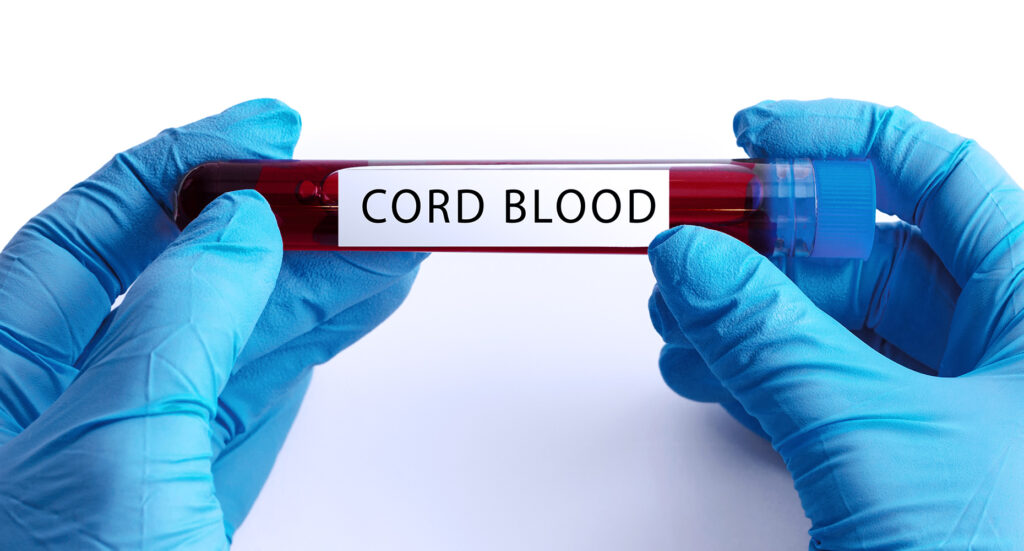What You Need to Know About Cord Blood
Pregnancy is a pretty astounding phenomenon: Millions of cell divisions, hundreds of biological processes and the formation of myriad numbers of structures lead to the development of a human being, all within the span of about 40 weeks. At the same time this miracle is occurring, your body is producing another miracle: cord blood. If you haven’t heard about the medicinal value of cord blood and are pregnant (or know someone who is), now’s the time to learn about it, as cord blood can only be collected immediately after childbirth. Read on to find out more about this potent elixir and how you can take advantage of all it has to offer.


What You Need to Know About Cord Blood
July 7, 2021
.
Pregnancy is a pretty astounding phenomenon: Millions of cell divisions, hundreds of biological processes and the formation of myriad numbers of structures lead to the development of a human being, all within the span of about 40 weeks.
At the same time this miracle is occurring, your body is producing another miracle: cord blood. If you haven’t heard about the medicinal value of cord blood and are pregnant (or know someone who is), now’s the time to learn about it, as cord blood can only be collected immediately after childbirth. Read on to find out more about this potent elixir and how you can take advantage of all it has to offer.
Why Cord Blood Is So Special
Cord blood, or blood collected from a woman’s umbilical cord after childbirth, contains hematopoietic stem cells, which have become the definitive treatment for many disorders.1 In fact, the American College of Obstetricians and Gynecologists (ACOG) states that these stem cells can be used to treat more than 70 different types of diseases.2
Hematopoietic stem cells are unique and incredibly valuable because unlike most other cells of the body, they can mature into any type of blood cell. Because of this ability, they can be used, for instance, to replace cells damaged by disease.3 The majority of other types of cells can only make copies of themselves, ACOG reports.3
Hematopoietic stem cells (we’ll refer to them simply as stem cells here) can also come from other sources, such as from a person’s bone marrow.2 However, those from cord blood offer greater benefits, including the following:
- Compared to the bone marrow collection process, which can be invasive and painful, collecting cord blood is simple, safe and painless.2
- Cord blood stem cells often can be used even if there isn’t an exact match between the donor and recipient. They also rarely cause rejection problems, which is more often the case with bone marrow stem cells.2
- While the stem cells from bone marrow must be used soon after collection, the stem cells from cord blood can be frozen and stored. While experts aren’t certain exactly how long cord blood can be stored, some believe it can safely last for more than 20 years, Stanford Children’s Health reports.4

The Diseases That Cord Blood Stem Cells Can Treat
According to the March of Dimes, more than 10,000 people in the U.S. are diagnosed each year with serious diseases that may be treated with stem cells.5 Although researchers are continually investigating new uses for cord blood stem cells, currently they may only be used to treat illnesses of the blood-forming system, the FDA states.6 These include:7
- Blood cancers, including leukemia and lymphoma
- Diseases of the bone marrow, including severe aplastic anemia, Fanconi anemia and pure red cell aplasia
- Hemoglobinopathies, including sickle cell disease and thalassemia
- Inherited immune system diseases, including severe combined immunodeficiency
- Inherited metabolism disorders, including Krabbe disease and Hurler syndrome
But that’s not all. Stem cells also can be used to help strengthen a person’s immune system when he or she is undergoing certain cancer treatments, according to ACOG.2 In addition, transplanted stem cells can help regrow blood cells that are killed during chemotherapy, the FDA reports.6
Researchers are also studying whether cord blood may be useful in the treatment of brain injuries, cerebral palsy, diabetes and Parkinson’s disease, the March of Dimes states.5
It’s important to note that cord blood stem cells often cannot be used in autologous transplants, or those in which the stem cells retrieved at birth are used to treat that same person. That’s because those stem cells carry the same genetic material as the other cells of the body. So if the person has a genetic disease, those stem cells carry the same genes that caused the disease. Autologous transplants also cannot be used to treat leukemia.2

How Cord Blood Stem Cells Are Collected
Cord blood collection can be done with either a vaginal or Cesarean birth. Immediately after delivery, the healthcare provider clamps the umbilical cord and then uses a needle to draw the blood from the cord and deposit it in a collection bag supplied by the cord blood bank where the stem cells will be stored (more on cord blood banks below). This must be done within 15 minutes of delivery.4
The cord blood is then sent to the cord blood bank, where it’s frozen and stored. According to Stanford Children’s Health, between half a cup and 1 cup of blood is typically retrieved during a collection.4 For healthy full-term babies, this can equate to more than 1 million stem cells!8
Since cord blood collection isn’t a routine procedure, the decision of whether to bank cord blood must be made early: The March of Dimes recommends by 28 to 34 weeks of pregnancy.5 The blood bank also must be notified well in advance of your due date so a collection kit can be delivered.2
Private vs. Public Cord Blood Banking
Cord blood can be stored at either private or public banks. When using a private bank, your cord blood is collected and stored to be used only by your family. With a public bank, you donate your cord blood for use by other people, although ACOG reports that some public banks may be able to store blood for you in what’s called a directed donation if you have a family member with a disease that could be treated with stem cells.2
Many people opt to store their cord blood at a private bank because the stem cells contained in the blood are an exact match for their baby and could be used to treat a serious medical condition that might develop in the future, such as an immune system disorder. Some experts speculate that the chance of a child needing his or her own cord blood stem cells is approximately 1 in 2,700.4 (And remember, using your own stem cells that have been treated, or autologous transplants, are often are not possible.) Other families choose to store their cord blood in a private bank because they want to have access to their baby’s stem cells in the event that another family member is diagnosed with a disease that could be treated with stem cells.4
The FDA requires that both public and private cord blood banks follow safety guidelines to reduce the risk of contamination and transmission of infectious diseases.6 However, the American Academy of Pediatrics (AAP) states that while public banks are heavily regulated, private banks are not subject to strict regulatory oversight and quality control. Also, while donation to a public bank is free, private banks require a fee upfront — often about $2,000 — plus yearly fees of approximately $100–$175.1
It’s important to note that many entities, including ACOG and the AAP, recommend cord blood donation to public banks.9 However, ACOG adds that private banking may be considered if a family member has a medical condition that could potentially be treated with cord blood stem cells.9
Whichever type of bank you decide on, experts recommend that you make sure it’s registered with the American Association of Blood Banks (AABB) and complies with standards established by the Foundation for the Accreditation of Cellular Therapy (FACT).1
With its lifesaving stem cells, cord blood has the ability to treat dozens of serious diseases, whether in your child, a family member or a complete stranger. We hope you’ll take a moment to appreciate the invaluable substance your body is producing, and to make plans to collect and bank it once your baby’s born. Doing so may just save a life.
Want More Information?
For a list of AABB-accredited cord blood facilities, visit:
https://www.aabb.org/standards-accreditation/accreditation/accredited-facilities/cell-therapy-services/aabb-accredited-cord-blood-facilities
For a list of FACT-accredited organizations, visit:
https://accredited.factwebsite.org
For a list of hospitals that collect cord blood to donate to public banks, visit:
https://bethematch.org/donatecord/
For answers to common questions about cord blood banking, visit:
https://bethematch.org/support-the-cause/donate-cord-blood/cord-blood-faqs/
Footnotes:
1 Shearer, William T. “Updated Policy Reaffirms Value of Public over Private Cord Blood Banks.” AAP News, June 2021. https://www.aappublications.org/news/2017/10/30/CordBlood103017.
2 “Cord Blood Banking.” American College of Obstetricians and Gynecologists, https://www.acog.org/en/womens-health/faqs/cord-blood-banking. Accessed June 2021.
3 “Frequently Asked Questions about Stem Cell Research.” Mayo Clinic, https://www.mayoclinic.org/tests-procedures/bone-marrow-transplant/in-depth/stem-cells/art-20048117. Accessed June 2021.
4 “Cord Blood Banking.” Stanford Children’s Health, https://www.stanfordchildrens.org/en/topic/default?id=cord-blood-banking-160-48. Accessed June 2021.
5 “Umbilical Cord Blood.” March of Dimes, https://www.marchofdimes.org/pregnancy/umbilical-cord-blood.aspx. Accessed June 2021.
6 Office of the Commissioner. “Cord Blood: What You Need to Know.” FDA, Sept. 2020. https://www.fda.gov/consumers/consumer-updates/cord-blood-what-you-need-know.
7 “Diseases Treatable by Transplants.” BeTheMatch.org. 24 Apr. 2018, https://bethematch.org/transplant-basics/how-transplants-work/diseases-treatable-by-transplants/.
8 “How Much Blood and Stem Cells Does a Typical Umbilical Cord Hold?” Parent’s Guide to Cord Blood Foundation, https://parentsguidecordblood.org/en/faqs/how-much-blood-and-stem-cells-does-a-typical-umbilical-cord-hold. Accessed June 2021.
9 “Umbilical Cord Blood Banking.” American College of Obstetricians and Gynecologists, https://www.acog.org/en/clinical/clinical-guidance/committee-opinion/articles/2019/03/umbilical-cord-blood-banking. Accessed June 2021.
Related Articles
Introducing the HemoCue Customer Portal